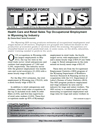Wyoming Occupational Fatalities Increased Slightly in 2012
The Research & Planning (R&P) section of the Wyoming Department of Workforce Services has reported that the number of occupational fatalities rose from 32 in 2011 to 35 in 2012, an increase of 3 deaths (9.4%; see Figure). On average, from 1992-2012 there were 34 occupational fatalities each year.
Variations in fatalities from year to year are to some extent the result of the random nature of work-related accidents. There is not always a direct relationship between workplace fatalities and workplace safety. For example, suicides and homicides that occur in the workplace are included as occupational fatalities. In other cases, a sudden illness may be nearly coincidental with an accident that results in a workplace fatality. Occupational fatalities are counted in the state where the injury occurred, not necessarily the state of residence or the state of death.
The fatality counts featured in this article are compiled by the Census of Fatal Occupational Injuries (CFOI) program (a joint effort of R&P and the Bureau of Labor Statistics or BLS) and may not match those from other programs, such as the Occupational Safety and Health Administration (OSHA) because of differences in scope and methodology. In addition to regular wage and salary employees, CFOI counts include volunteer workers and self-employed individuals. The CFOI program utilizes a wide variety of data sources, such as OSHA reports, workers’ compensation, vital records, coroner’s reports, media reports, and police reports of vehicle crashes.
Additionally, similar data sources from other states are routinely used to identify workplace fatalities. For example, a worker fatally injured in a highway incident in Wyoming may be covered by workers’ compensation in another state. That information is made available to R&P as part of data sharing agreements between the states and federal government (BLS).
In 2012, the largest number of deaths occurred in trade, transportation, & utilities (12, or 34.3% of all deaths; see Table). Within that category, 10 deaths were in transportation & warehousing (28.6%). Natural resources & mining accounted for 10 deaths (28.6%), of which seven were in agriculture (20.0%) and three in mining (8.6%). Three deaths ocurred in construction (8.6%) and three in government (8.6%). Nearly half (48.6%) of workplace fatalities were the result of transportation incidents.
From 2003-2012, transportation incidents made up 60.2% of all workplace deaths. Transportation incidents include highway crashes as well as incidents involving aircraft and other vehicles.
More information on occupational fatalities for Wyoming is available at http://doe.state.wy.us/LMI/CFOI/toc.htm. In addition to the data published in this article, the website includes statistical information on several characteristics of the fatal occupational injuries in Wyoming, such as type of event or exposure, age of the worker, injuries by industry sector, and more.
For official definitions used in the CFOI program, visit http://stats.bls.gov/iif/oshcfdef.htm.
David Bullard can be reached at David.Bullard@wyo.gov.


